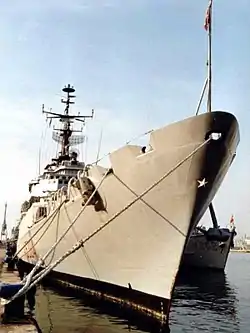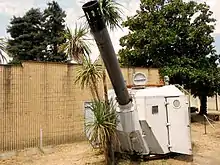Italian frigate Alpino (F 580)
Alpino was a frigate operated by the Italian Navy during the Cold War.
 Alpino docked in Málaga after 1996 | |
| History | |
|---|---|
| Name: | Alpino |
| Namesake: | Alpini |
| Ordered: | 1959 |
| Builder: | Cantieri Navali Riuniti (CNR), Riva Trigoso, Genoa |
| Laid down: | 27 February 1963 |
| Launched: | 10 June 1967 |
| Commissioned: | 14 January 1968 |
| Decommissioned: | 31 March 2006 |
| Motto: | Italian: Di qui non si passa “From here you do not pass” |
| General characteristics as built[1] | |
| Type: | Frigate |
| Displacement: | |
| Length: | 113.30 m (371 ft 9 in) |
| Beam: | 13.10 m (43 ft 0 in) |
| Draught: | 3.8 m (12 ft 6 in) |
| Propulsion: |
|
| Speed: |
|
| Range: | 3,500 nmi (6,500 km; 4,000 mi) at 18 knots (33 km/h; 21 mph) (diesels) |
| Complement: | 263 |
| Sensors and processing systems: | |
| Armament: |
|
| Aircraft carried: | 2 × AB-204[2] or AB-212ASW[3] helicopters |
| Aviation facilities: | Telescopic hangar for 2 medium helicopters. |
Design
The Alpino-class frigate was designed by CNR in Riva Trigoso and named after types of soldiers and specifically after two World War II Soldati-class destroyers. The design was authorised in the 1959/1960 Italian naval programme but was radically redesigned in 1962. Circe was laid down as the lead ship in 1963 but was renamed Alpino in June 1965 prior to being launched in 1967.[4]

As originally designed, Alpino was to have armament based on the preceding Canopo-class frigate.[4] Optimised for anti-submarine warfare, the vessels were designed around a hangar for an Agusta-Bell AB.204 helicopter, complemented by a single-barrel 305 mm (12 in) Menon mortar mounted forward. An early drawing shows the hangar straddled by a pair of 40 mm (1.6 in) guns with a single 76 mm (3 in) gun mounted fore and aft to provide anti-aircraft defence.[5] By 1962, the efficacy of the 40 mm was in doubt and the design was redrawn with three 76 mm guns, but this was deemed insufficient. At launch, the vessel had no less than six single mounts.[2]
The propulsion system uses a combined diesel and gas (CODAG) system first trialled on the destroyer San Giorgio. The system allied two diesels and one gas turbine per shaft with a hydraulic coupling to enable the vessel to either run on diesel power alone, at low speed, or diesels, at high speed, and gas turbines simultaneously.[6] Two 4,200 shp (3,100 kW) Tosi OTV-320 diesels were paired with each 7,500 shp (5,600 kW) Tosi-Metrovick G.6 gas turbine to provide a maximum speed of 20 kn (37 km/h; 23 mph) on diesels alone and 28 kn (52 km/h; 32 mph) with all engines running.[7]
Service
Commissioned on 14 January 1968, Alpino quickly made a mark as a pioneer of sharply raked bows, the first frigates so equipped in Italian Navy service, as well as gas turbines and variable depth sonar.[5] Between 14 January and 6 June 1973, the ship undertook the longest continuous voyage in the Italian Navy, covering 7,315 nautical miles (13,547 kilometres; 8,418 miles) and travelling as far as the Labrador Sea, for which it was awarded a symbolic Blue Nose.[8]
Alpino acted as the trial ship for the experimental SPQ-5A Sarchiapone radar between 1973 and 1987. It was reportedly able to locate aircraft during their take-off from the aircraft carrier USS John F. Kennedy at a distance of 350 nautical miles (650 kilometres; 400 miles).[9]
A SLQ-A ECM system was also added during the 1970s.[5] This was subsequently upgraded to SLQ-D.[1] Consideration was also given to installing the Sea Wolf surface-to-air missile system to improve anti-aircraft capability.[10]
The ship was further upgraded during a refit that ended in June 1985. Hull-mounted sonar was fitted and the variable depth sonar rendered inoperable.[11]
Mine warfare flagship
| General characteristics after 1997[12] | |
|---|---|
| Type: | Minehunter flagship |
| Displacement: | |
| Length: | 113.30 m (371 ft 9 in) |
| Beam: | 13.10 m (43 ft 0 in) |
| Draught: | 3.8 m (12 ft 6 in) |
| Propulsion: |
|
| Speed: | 22 knots (41 km/h; 25 mph) |
| Range: | 3,500 nmi (6,500 km; 4,000 mi) at 18 knots (33 km/h; 21 mph) |
| Complement: | 163 |
| Sensors and processing systems: |
|
| Electronic warfare & decoys: | SLQ-747 |
| Armament: |
|
| Aircraft carried: | 1 × AB-212ASW helicopter |
| Aviation facilities: | Telescopic hangar for 1 medium helicopter. |
Between 14 April 1996 and 31 January 1997, Alpino was converted into the flagship for minewarfare, a mine countermeasures support ship, a combat diver support ship and signals intelligence ship with the new penant number A5384.[11][13] The vessel acted in the flagship role to the Gaeta-class minehunters Crotone and Chioggia from 18 March to 22 June 2002 during a NATO training exercise in Northern Europe. From 13 May 2004, Alpino commanded MCMFORSOUTH while on exercise in the Black Sea.[14]
Thirty-eight years after being originally commissioned, the ship was decommissioned on 31 March 2006.[15]
References
- Gardiner, Roger; Stephen, Chumbley (1995). Conway's All the World's Fighting Ships 1947–1995. Annapolis, Maryland, USA. p. 210". ISBN 1-55750-132-7.
- Blackman, Raymond V.B. (1971). Jane's Fighting Ships 1971–72'. London: Sampson Low, Marston & Co., Ltd. p. 187. ISBN 0-354-00096-9.
- Moore, John (1985). Jane's Fighting Ships 1985–86. London: Jane's Yearbooks. p. 273.
- Fitzsimons, Bernard (1979). The Illustrated Encyclopedia of 20th Century Weapons and Warfare. Milwaukee: Purnell Reference Books. p. 90.
- Gogin, Ivan (2015). "ALPINO frigates (1968)". Retrieved 26 February 2018.
- Fortunato, E.; Clements, H.A. (1979). "Marine Reversing Gear Incorporating Single Reversing Hydraulic Coupling and Direct-Drive Clutch for Each Turbine" (PDF). ASME 1979 International Gas Turbine Conference and Exhibit and Solar Energy Conference. American Society of Mechanical Engineers: 4–5. Retrieved 26 February 2018.
- Avery, Derek (1987). Modern Warships. London: William Collins. pp. 130–131.
- Vinciguerra, Pancrazio (2011). "Viva l'equipaggio "Naso Blu" di Nave Alpino" (in Italian). Retrieved 26 February 2018.
- Galati, Gaspare (2016). 100 Years of Radar. New York: Springer. p. 349.
- Hewish, Mark (1976). "World Missiles". Flight International: 1440. Retrieved 26 February 2018.
- Wertheim, Eric (2005). The Naval Institute Guide to Combat Fleets of the World. Annapolis MD: Naval Institute Press. p. 346.
- Saunders, Stephen (2005). Jane's Fighting Ships 2005–2006. London: Jane's Yearbooks. p. 385.
- Baker, A.D. (1997). "Combat Fleets". Proceedings. United States Naval Institute. 123 (6): 93–94.
- "Cambio al Comando della Forza NATO di Contromisure Mine Sud Europa". Giornale di Bordo. 2004. Retrieved 26 February 2018.
- "Almanacco storico navale: Alpino (F 580 - A 5384)" (in Italian). Ministero della Difesa. Retrieved 26 February 2018.
